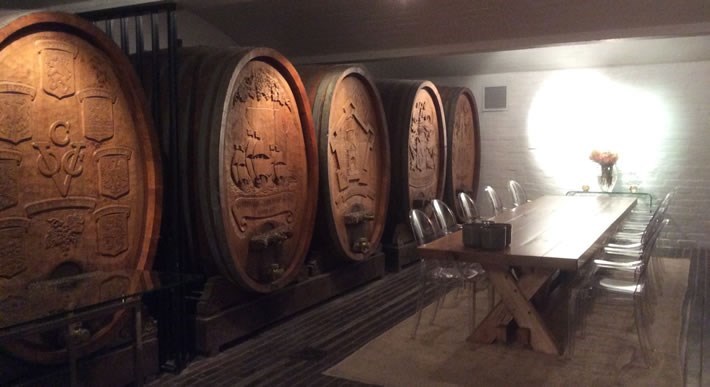Not only that, but an opportunity to meander round a wine museum, taste some wines, buy some older vintages and delve into the recesses of a 50 year old cellar in a mountain; literally a Bergkelder.
In fact, many do know, that Die Bergkelder, part of the Distell company and home of Fleur Du Cap, conducts four tours a day, six days a week and can welcome 60 or 70 people a day. For R60 you can be led around much of the site by an informed staff member, so that is what I did. A Swedish lady smiled and giggled when she learnt all that was included for the R60; good value in any language – I guess that is a cup of tea in Sweden.
Just nine people were on my 11am tour and after taking pictures and marvelling at the beautiful old machinery and presses from bygone centuries in the museum and perusing the tempting older vintages (a 1993 Chateau Libertas got my attention), Graydon led us off, stopping for shade under the thatch of a nineteenth century German wine press bigger than our group, to the barrel maturation cellar, lovely and cool on a day of 33˚C. The area can hold 28,000 barrels if needed, but had just 8,000 of their top cuvées presently. Only some wines of some brands see barrel maturation, and winemakers are standardising at the 300L size, from France, the US, Hungary and Romania. We passed many white wines in full fermentation mode, their air locks threatening to fly off. Visitors pressed their ears to the barrel to witness the gurgling going on within.
Past the Vinoteque, where you can store your own wines for a nominal fee, then over the footbridge crossing the Plankenburg River to the Bergkelder, carved into the Papegaaiberg in 1968 to house a growing stock of wines, but now more of a showpiece as many of the wines stored would be undrinkable. It is the most sensible storage facility, the first of its kind in the Southern hemisphere, the depth and dark keep it a constant cool temperature and the principle is common all over Europe. Here you can cross the tiled dimly lit cell-like recesses each full of laying bottles, moist with fungus and with black mould taking over – a most delicious sight to any wine lover. Tasting occurs here, quite rightly, as the cathedral-like atmosphere sets the tone nicely. Five wines are offered from the Fleur Du Cap range, not the Laszlo sadly, the most appreciated being the Unfiltered Cabernet Sauvignon 2013 and the Unfiltered Chenin Blanc from 2014 proved rich and delicately creamy. My favourite, the tangy and viscous Noble Late Harvest 2011 – a Platter’s 5 star wine - was the least liked and even I was surprised to hear (it seemed so perfectly balanced) that the Residual Sugar level in it was 182g/L (the 2013 has 235g/l); perhaps the Germans on the tour had a point with their, ‘too sweet!’. Pictures were taken beside the rows of old foudres barrels, carved with scenes from the Cape.
We passed back through a row of 15 steel tanks of 46,000litre capacity and there were other tanks around, you got an impression of just what an undertaking Distell manage. Bottling was in progress, it looked like the Fleur Du Cap Natural Light, so we stopped over the machines that could fill 12,000 bottles per hour; that is some 200 a minute! The rattle and movement was hypnotising, until you saw the effort needed by the workers at the end removing two bottles at a time for checking and packaging. Many Distell brands such as Durbanville Hills, Fleur Du Cap and Two Oceans may be bottled here.
The mind boggled at the thought of being involved if ever the Bergkelder needed to bottle its full capacity at any time, on average some 12million litres – or 16million bottles – a year. By necessity, bottling occurs when needed or when possible, either way I would arrange to be off ill those months. Then back to the start, having asked all our questions visitors piled into their taxi, having enjoyed a piece of Winelands history, for the price of a cup of tea back home.
